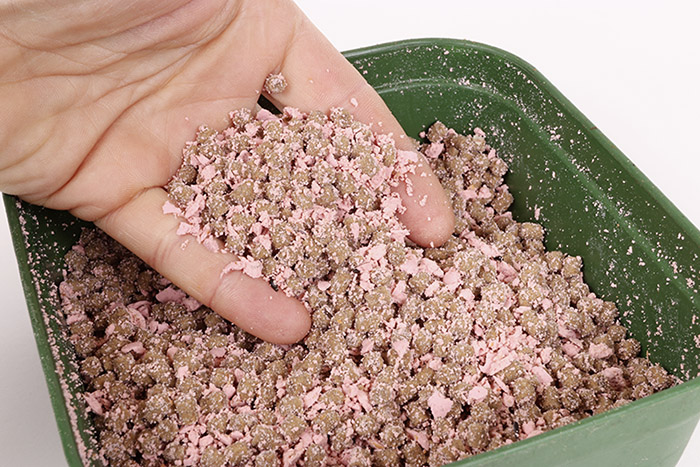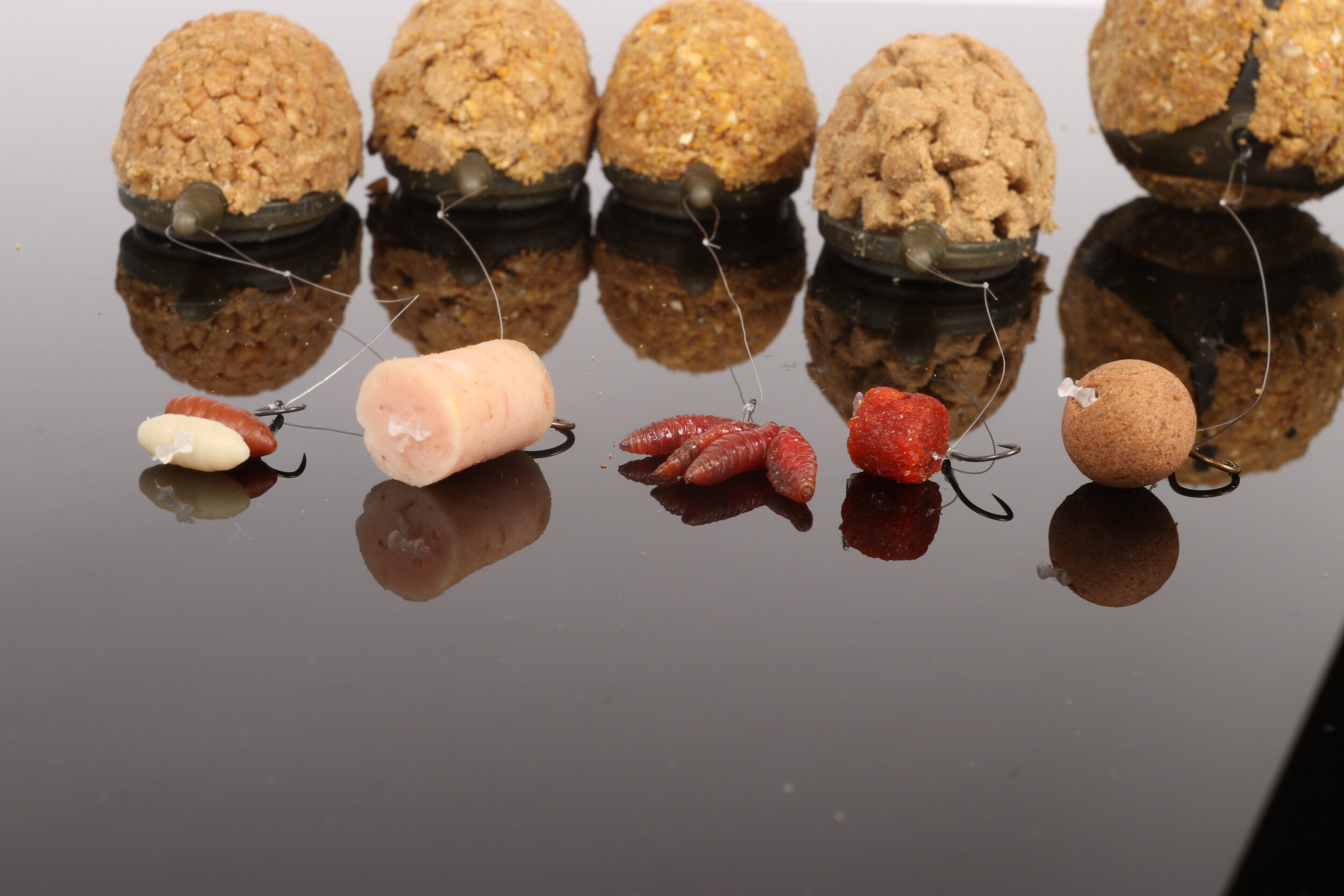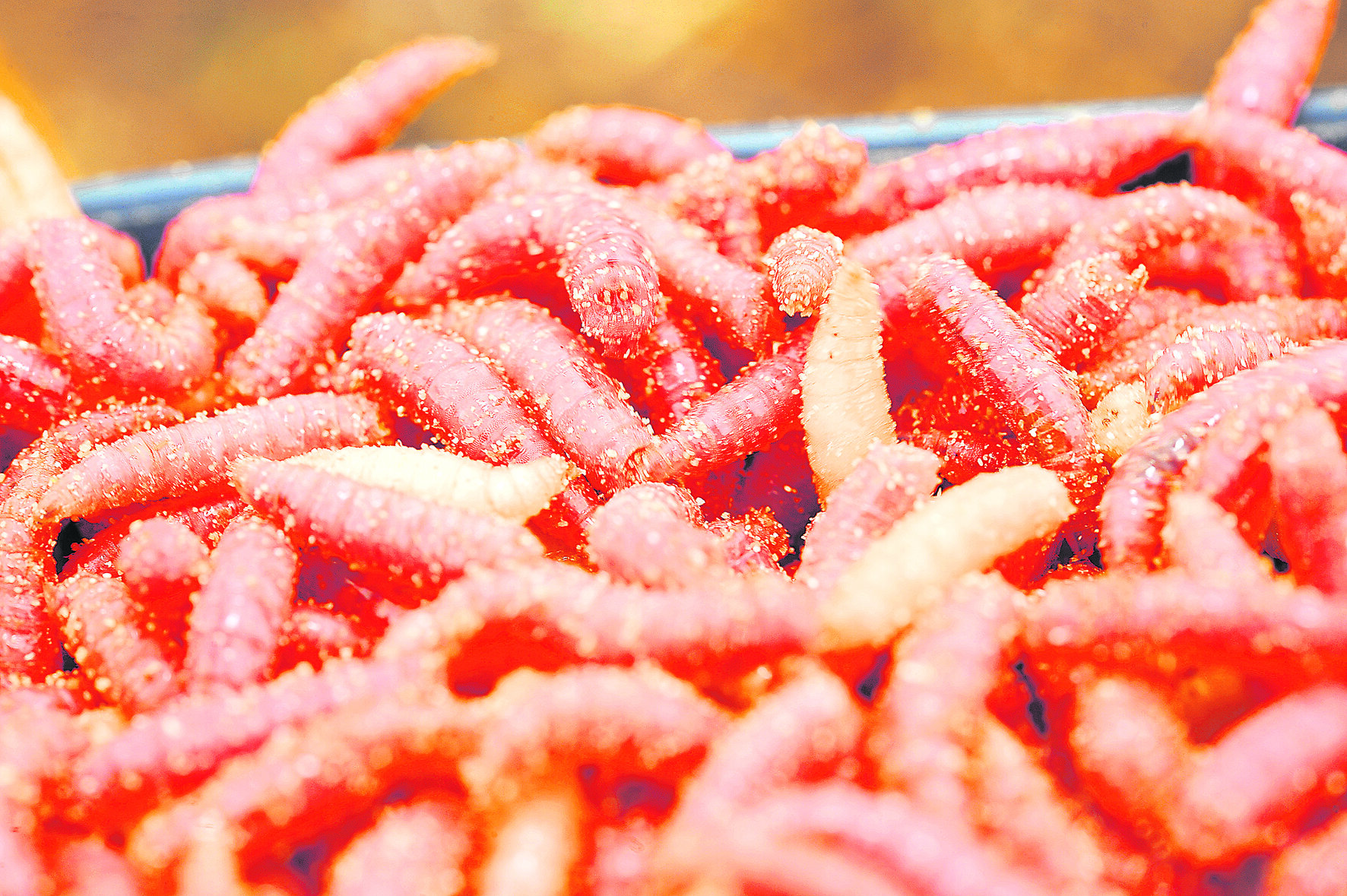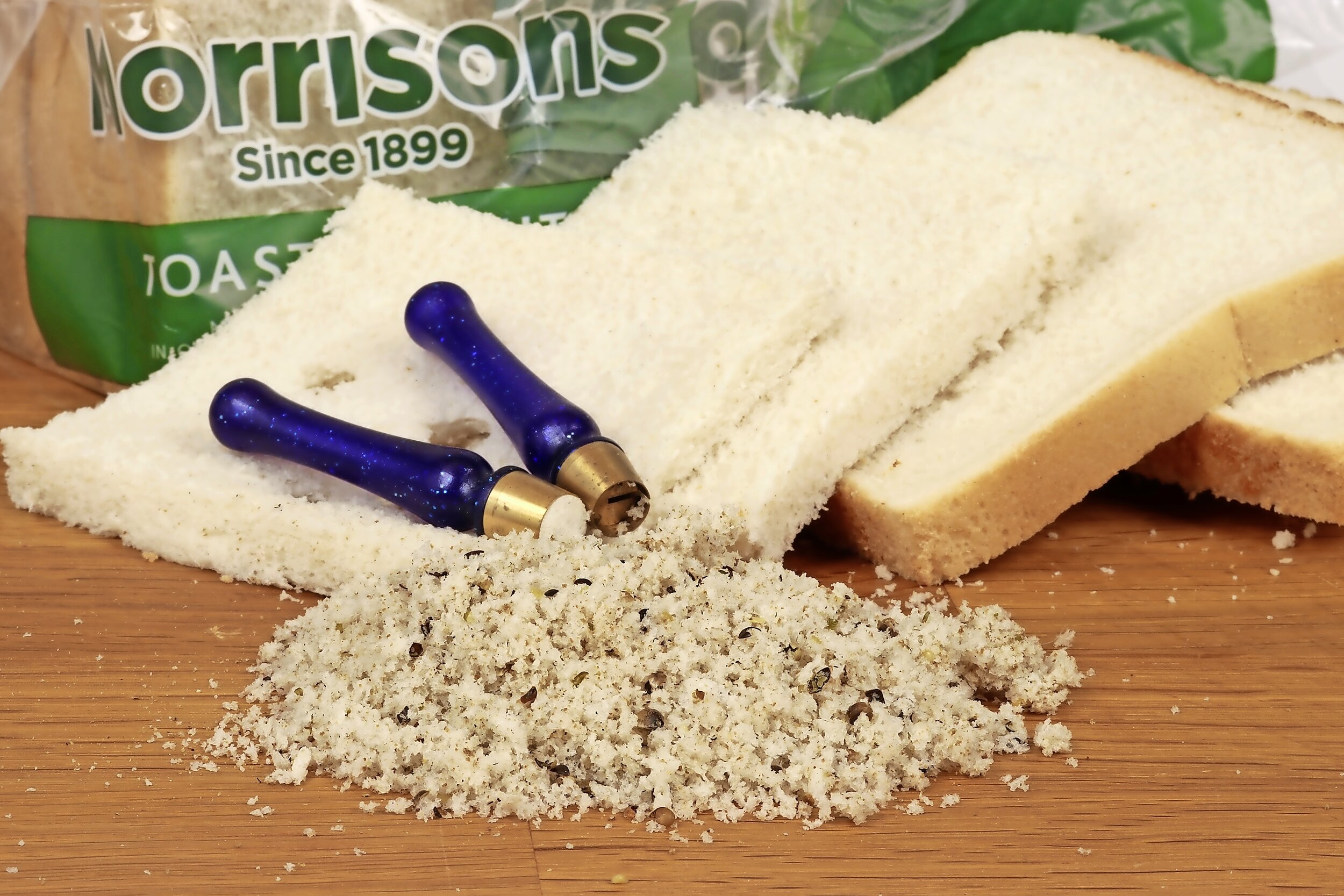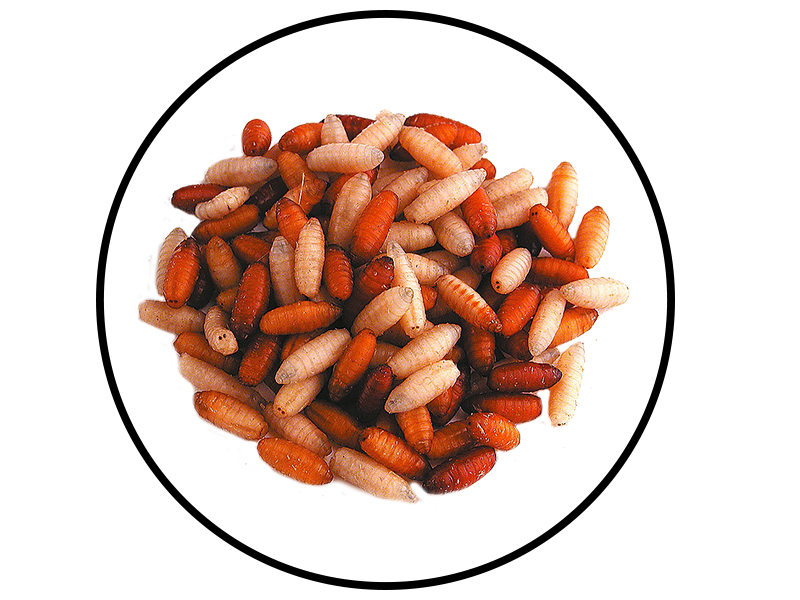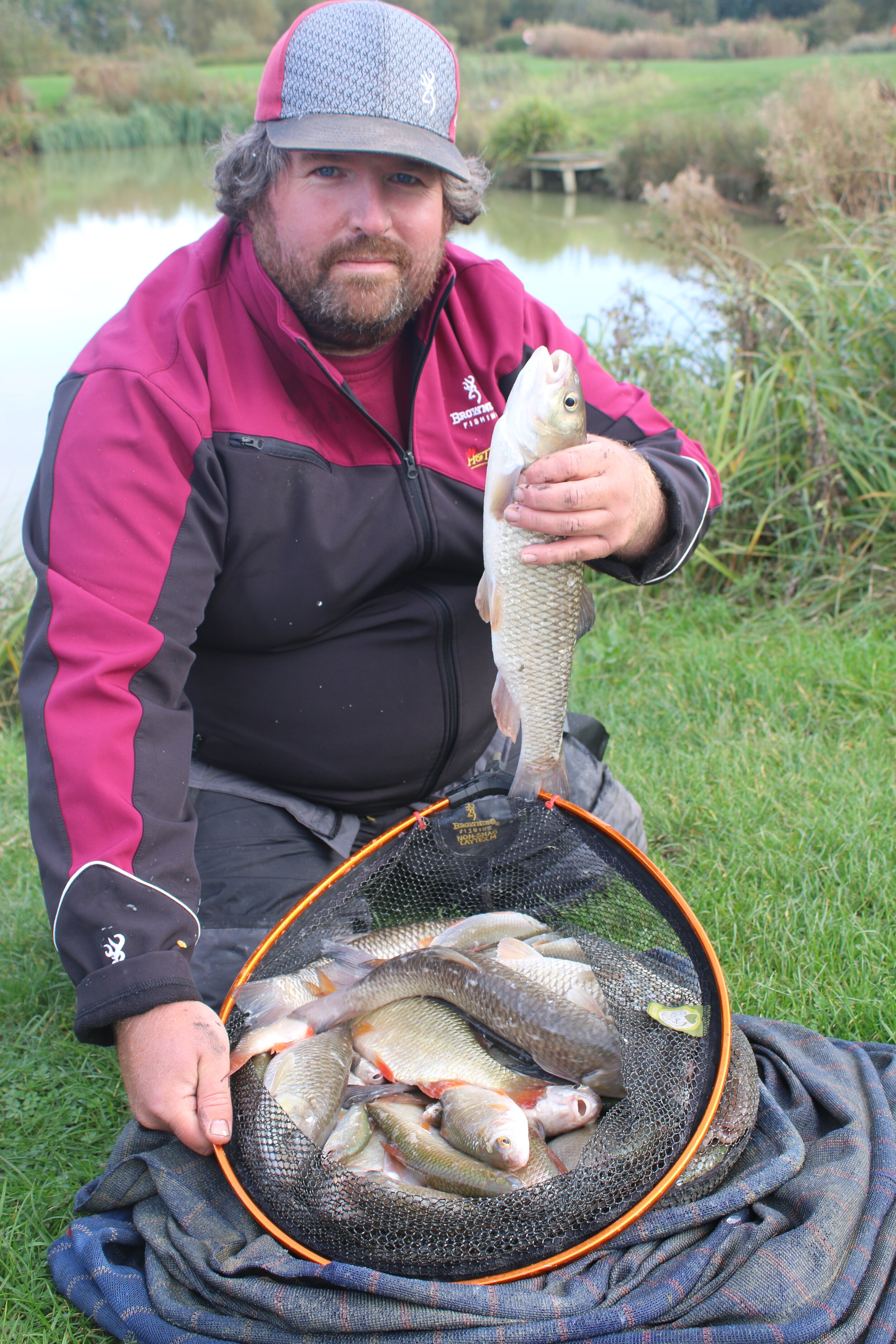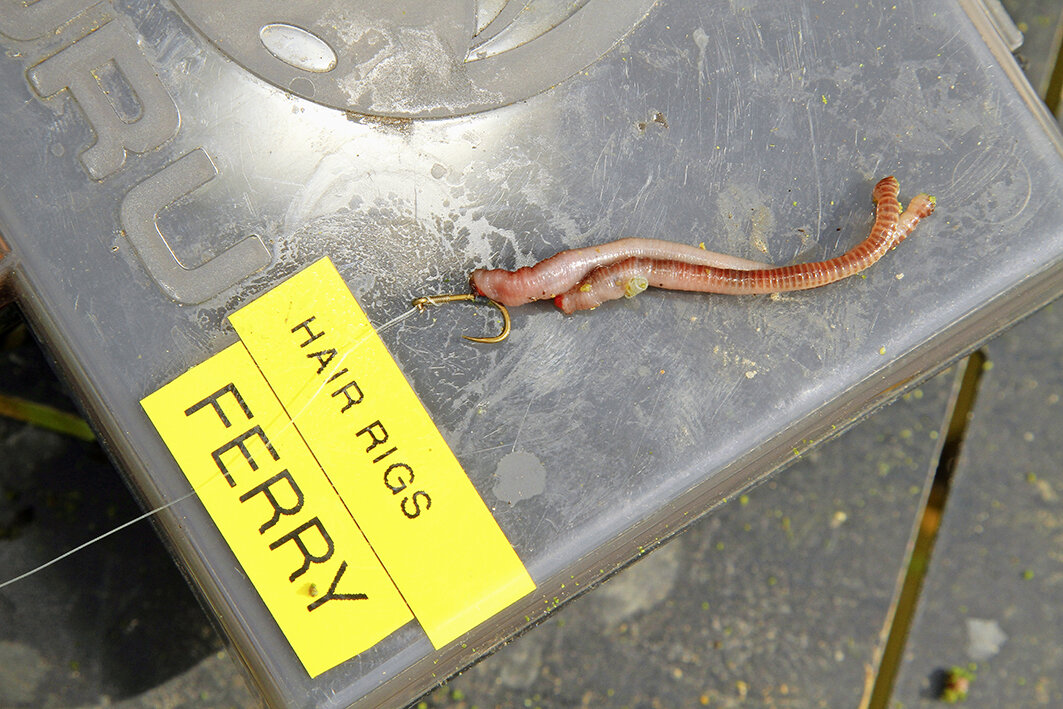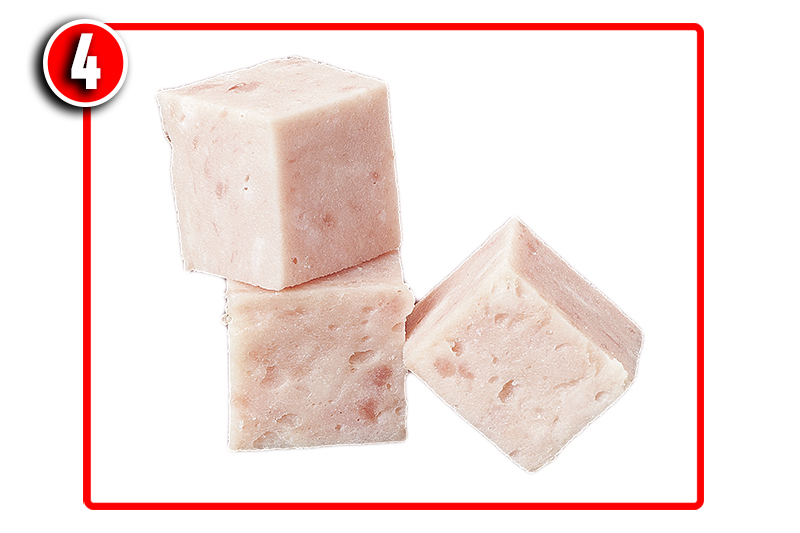Boost your pellet bags and catch more
Most anglers will use fishery pellets straight from the bag in their teabags, but they really could do with a boost when the water is really cold. Fortunately, this is easily achieved and takes just a few minutes – just follow my handy guide below.
1) Add a splash of Tiger Nut drink to the dry pellets. This needs to be just enough for a light coating so that is soaked up and slightly softens the pellets.
2) Crush a handful of Strawberry Crush boilies to a fine powder. Boilies are denser than pellets and so tend not to get washed around the swim by the carp so much.
3) Add about 25 per cent crushed boilie to the pellets. Crushing the boilies releases their attraction much faster won’t fill the carp up as whole ones would.
4) Add a pinch of the pellet and boilie mix to a PVA stick but not too much – you want to attract the carp, not give them food to compete with your hookbait.
5) Compress the bait in the PVA stick and tie off the end. For winter fishing you are aiming
to make a teabag around the 20mm-30mm diameter mark.
6) Use a safety boilie needle to pull the hooklength through the side of the PVA teabag and pull the hookpoint gently into the side of this compact PVA stick.
The best deadbaits to use when pike fishing
Deadbaiting is the number one big pike tactic in the UK.
But while deadbaits are easy to buy from your local tackle shop or fishmonger, the more I have fished for pike, the more fussy I have become over the ones that I use.
Not only should they be as fresh as possible, but they also need to be the right size. Smaller is often better in this case, simply because it is easier for even a big pike to pick up a 6ins bait than one twice this size.
Smaller baits are easier to use and lead to fewer dropped runs. So, if I can only get hold of big baits, I will normally halve them to give me a more manageable size. Check out the best deadbaits to use for pike fishing below
LAUNCE
Giant sandeels, these long thin fish on their day are up there with the best of baits. Ideal for long-range fishing, but pike find them a little tricky to pick up off the bottom so I always take the head off to make a smaller bait and balance them with a Bait Flipper.
TROUT
Brown trout are particularly effective, being tough and quite buoyant. Ideal for sink and draw fishing, as well as using under a float. The golden variety is very bright and is worth searching out as a good change bait.
SMELT
My ‘go-to’ bait on most waters – the white colour stands out well and even a very large smelt is a perfect pike bait. Smelts quite tough and will often withstand several casts. They can be dyed easily and take a flavour well.
HERRING
I like the small ‘jacks’ of about 8ins. If you can only obtain larger herrings, try chopping them in half. A very oily bait, herrings are effective on most venues. Their flat profile means that they will sit well over light weed and silt.
SARDINE
Much softer than herrings, but of a similar shape and smell. On some venues they out-fish even smelts. Best used whole and cast out frozen, because of their soft flesh. Expect to get just one cast from each bait.
ROACH
A tough bait that on many venues makes up most of the pike’s diet. Try to buy roach that are in good condition. They will last several casts and are ideal for wobbling or twitching back. Make sure they sink by puncturing the swim bladder and squeezing the air out.
POLLAN
This strange whitefish is very much hit-and-miss on many waters. I like to use them on rivers, where their natural buoyancy makes them ideal for popping up, and they will sway gently in the current. A tough bait, and one that casts well.
MACKEREL
Mackerel have caught me a lot of pike over the years, including my personal best. Getting hold of the right size and the freshest baits can be difficult in winter, so stock up when you find some good examples. I like ‘joey’ mackerel that are about 8ins long.
LAMPREY
These prehistoric fish have a very chequered track record in my book. They work best on rivers that get a lamprey run each year, such as the Wye, but I have also caught using them on gravel pits. Ideal for long-range fishing, thanks to their shape.
how to make pellet boilies
A cheap and easy way to make your own boilie hookbaits is with ground halibut pellets. This might seem like a lot of effort to go to to make what in effect are just soft pellets, but these are very tough and easy-to-use hookbaits that can be flavoured, coloured and made more buoyant – in effect, customised to your liking.
1) Use a coffee grinder (preferably one bought solely for your own bait-making use) to reduce a couple of handfuls of halibut pellets to a fine powder.
2) Break a large egg into a bowl and add a teaspoonful of hemp oil, half a teaspoonful of Umami paste and four drops of Black Pepper Oil.
3) Slowly add the halibut pellet powder to the liquid egg until the mixture takes on the texture of a soft paste such as you might use on the hook or as a boilie wrap.
4) Boil the sausages for around one minute and then allow them to cool on a piece of kitchen roll to soak up the excess moisture.
5) Boil the sausages for around one minute and then allow them to cool on a piece of kitchen roll to soak up the excess moisture.
6) Cut the sausages into chunks and freeze them until needed. A few drops of hemp oil added to the tub will boost the baits further.
How to use hemp correctly when fishing for roach
Hemp is still a bait that so many anglers steer clear of when it comes to fishing for roach.
The seeds are fiddly to get on the hook, and when the angler finally gets a bait in the water he’s unable to catch anything.
That’s far from the truth. It may not every day that sees hemp work, but when you’ve got a swim producing a fish a cast on maggots and casters, there’s no reason why changing to hemp should lead to a halt in bites – provided of course, you’ve been feeding hemp from the word go.
This week’s coach is a real blast from the past – Pete Jayes. The Leicester angler has enjoyed a glittering career stretching back to his days with Ivan Marks and the Likely Lads.
Here are his top tips for catching big roach on ‘the seed’ this autumn…
Present it correctly
“Whereas maggots and casters are best fished overdepth, I think hemp works brilliantly when presented just off bottom and run over just a few feet of a river swim as opposed to way down the peg.
“I try and get the grain on the hook to act in the same way as the loosefeed underwater. Hemp on the riverbed won’t move with the flow, due to its weight, so why should the hookbait?
“I think roach line themselves up in the flow waiting for the hemp to arrive – if the bait acts suspiciously they won’t look at it.”
When tares work
“I never fish hemp without having a few tares with me because they are a brilliant hookbait that picks out the bigger roach in the swim. They are a much bigger bait than a grain of hemp, and they’re also easier to get on the hook.
“Once the roach are lined up on hemp it’s time to try a tare on the hook. I prepare my own, but to make them even softer I will freeze a few and then defrost them before use.”
Different rigs
“I always have two pole rigs on the go for hemp work because no two days are ever the same.
“You have to try different depths and shotting patterns to make the hookbait behave as much like the loosefeed as you can.
“I’ll fish a 0.4g bodied float plus a much lighter 4x14 slender Preston Innovations Chianti model. Both are shotted using nothing larger than No10 shot, as this allows me to move them up and down the line for different presentations. You can’t do that with heavier shots.”
feeding
“Varying how many grains of hemp you loosefeed is the road to ruin. I reckon roach like a constant stream going in – the more regular the feeding is, the better the fishing will be, so I fire in around 12 grains every run through and never alter this.
“Should I think that a change needs to happen, this comes by altering the shotting on the rig rather than how much I am feeding.”
Light lines, small hooks
“In keeping with the delicate presentation that I am trying to achieve, my lines and hooks have just as much finesse.
“A hook that’s too big and a line that’s too thick will make the hookbait act unnaturally underwater, so typically I fish 0.10mm mainline to an 0.08mm hooklink.
“Your hooks should be very light as well, but they need to have a wide gape to help the hemp sit properly.
“For me the best out there is a Kamasan B511 in a size 20 or 18.”
The best bait to use for roach
Like most anglers I love fishing for roach, and while other species may grab my attention throughout the year, my season wouldn’t be complete without a campaign for these amazing fish.
We often take roach for granted, given that they can be found in almost every river, lake or canal, but this disguises the fact that they are superbly adapted to such a wide range of different environments.
One of the factors that enables roach to be so successful is their ability to eat a wide range of different natural foods. If you look at the mouth of a roach it isn’t specialised, which hints that roach are the all-rounders of the coarse fish world. Roach are equally adept at feeding on small snails as they are bloodworm.
Emerging insects will get them to rise in the water column to feed, whereas an abundance of caddis larvae may seem them feeding on the bottom. Roach will even chomp mouthfuls of algae from the surface of water plants and stones, even though they can only digest the tiny animals that are hidden within.
It should be no surprise that roach will feed on a wide range of different baits too, but choosing the right one for each situation can make all the difference to your catches.
By thinking about how the roach are behaving in each season we can see why our tactics need to change throughout the year.
AUTUMN
This year I am expecting some great river roach sport, thanks to the regular rain giving running waters a welcome tinge of colour.
This definitely improves roach sport, which reaches a climax as the light-level falls in the evening. Seed fishing with hemp and tares is what autumn evenings were made for, although a handful of casters for hookbaits will see bites often easier to hit and can bring a bigger stamp of fish.
Other alternatives to try at this time of the year are stewed wheat and groats, both very cheap to buy and easy to prepare, along with elderberries that make a useful hookbait.
Feeding little-and-often is the key with all of these baits. A pinch of seeds every minute will get the roach competing. If you are impatient, try starting with a maggot on the hook, as it can take a while for the roach to feed confidently on seeds.
At this time of the year the roach are often feeding on tiny black water snails, which I am sure explains the effectiveness of these dark baits.
WINTER
The depths of winter are my favourite time to fish for roach because they can be relied to feed in conditions that most would regard as hopeless. In fact, really cold weather can be the best time to target specimen roach because, for some reason, the small fish will go off the feed, but the specimens will still take a bait, especially in the first hour of darkness.
With small fish out of the equation, this is the time of year to use maggots both as feed and on the hook. I like to carry a mixture of white and red grubs, normally flavoured with pineapple, and use a combination of the two colours on the hook.
For river fishing you may find that dace and chublets make maggot fishing tricky. If this is the case then switching to bread can be more selective. Rather than use flake, as many roach anglers advise, I tend to use an 8mm punch of bread instead, finding the smaller offering more acceptable in the cold. Feed a mixture of fine punch crumb and liquidised bread that has been dampened down enough to hold together when squeezed firmly.
With natural food at a seasonal low, roach have to use all their resourcefulness to find enough food in winter. Often they will be full of algae, which has little nutritional value, but which does hold some tiny invertebrates that they can digest. I am sure that it is the lack ofbetter quality natural food, combined with the desire to feed, that makes roach so catchable in the depths of the winter.
SPRING
Water temperatures tend to rise much more slowly than air temperatures, so by the time my spring tactics come to the fore, the rivers will have closed and so my roach fishing will take place on stillwaters. With spawning taking place around mid-May, the roach will be looking to eat well at this time of the year in order to build up their reserves. Larger baits such as worm and caster can be the roach angler’s best friend during this period. Try using a cocktail consisting of half a dendrobaena worm tipped with a caster on a size 14 hook.
Evening fly hatches will see roach shoals coming up in the water and often topping on the surface at dusk. Try fishing two casters on the hook, which is a slow-sinking hookbait, and feed pinches of caster over the top to attract the larger roach.
SUMMER
Very few roach anglers bother fishing for the species during the summer, but they could be missing out. A lot of big roach are accidentally caught by carp anglers using particle baits and mini boilies so I would base my tactics around these baits.
I have found sweetcorn particularly effective on rivers during summer. Try fishing the first couple of hours into darkness with a light scattering of grains and some hemp. This has worked particularly well for me.
Mini boilies are probably the most selective big-roach bait there is. I stick to 10mm baits, given the relatively small mouth of even a two-pounder.
Best winter baits for fishing
For many anglers, now is the time when sport is at its very best.
Most species are feeding up hard to pack on weight for winter, and a well-presented bait will see plenty of action. We start with 15 autumn-gold nuggets of advice from big-fish expert Dr Paul Garner...
1) Try dead maggots or worms
Two baits stand out for crucians right now – two dead maggots fished over a light scattering of groundbait can work wonders, but a close second comes half a dendrobaena, hooked at the broken end to leak off the juices.
2) It's a wrap for barbel
When boilie fishing for barbel I rarely cast out without wrapping some matching paste around the hookbait. This can work wonders if the fish are proving finicky. A useful trick is to use a 12mm hookbait wrapped in paste, but feed 15mm baits.
3) Gob-stoppers trick wily carp
With everyone using boilies of 18mm or less, you can fool wary carp by going large and 24mm or even larger baits. Scale up your hook size ti match the big bait.
4) Enjoy traditional roach sport
Many of our larger rivers are teeming with roach at the moment. One of the nicest ways of catching them is to use loosefed hemp with prepared tares on the hook.
Start with a pinch of hemp every cast and fish a matching grain on the hook. Once you start getting bites regularly swap to a tare and your reward should be a bigger stamp of fish.
5) Big bream are feeding up
A windy autumn can see shoals of big bream feeding hard. I lay out a big spread of bait to hold the shoal.
Into the mix go a tin of sweetcorn, two pints of dead maggots, some mini-boilies and soaked flaked maize. Bind the lot together into balls with a mix of brown crumb and layers mash.
6) Mid water baits for Rudd
For consistent autumn rudd sport try using a 10mm pop-up or a lump of breadflake on a 12ins-36ins hooklength, so the bait is presented in midwater
7) Stock up now
Get your deadbaits stocks sorted now to ensure a ready supply for winter. Big smelts are always in short supply, so order early.
Split bulk baits into small airtight bags and freeze down. Dip each bait in cold water before freezing, as this will stop them getting ‘freezer burn’.
8) swap to a cone
A pellet cone is a much neater presentation than the Method feeder, and really comes into its own in the coming weeks, especially on venues where the carp have seen it all over the summer months. Vary the size of the cone to control the amount of feed you introduce.
9) The subtle snowman
Very often carp never actually get the hook into their mouths, just the boilie. This can be even worse with a snowman presentation. So try my ‘subtle snowman’ (below), made by cutting a 15mm boilie and a 15mm pop-up down to form a single back-to-back bait.
10) Feed, feed, feed for chub
The key to unlocking brilliant autumn chub sport comes down to how you feed. The simple solution is to drip-feed as regularly as you can. This could be as little as three pellets or maggots every few seconds.
11) Fry-feeding perch
Now is the time to target perch, which predate heavily on small fish which are in the margins over the next few weeks. Use small lures for this – a selection of bright green and more natural hues.
12) Go soft for roach
On many fisheries roach have developed a love of pellets. This can cause problems with fast, hard-to-hit bites. This phenomenon is simply down to both baits being hard, and to combat this try using soft hooker pellets – I find 4mm baits are best.
13) Flavoured meat in floods
Try to coincide barbel trips with the river falling back after a flood. If you have to fish as the river rises, stick to a straight lead and a large smelly bait such as Crab & Krill flavoured luncheon meat.
14) Slug it out for chub
Dew-laden mornings will see hundreds of slugs and snails attacking your garden plants. Rather than chuck them over the neighbour’s fence, why not collect them for an afternoon’s chub fishing?
15) Try red corn down the edge
A float down the edge works for carp that feed in the margins at dusk.
Add a few drops of boilie dye to a tub of corn the day before fishing and you will be left with a lovely dark-red bait that is eaten with enthusiasm.
How to make paste for carp fishing
Many anglers think that paste is for commercial carp fishing only when really it can be used in all types of carp fishing and is definitely a worthwhile tactic to look at next time you are on the bank. We've gone to paste expert Colin Spencer who will real how he has perfected this simple and extremely effective bait
No-shot rig
“One of the most frustrating elements of paste fishing is trying to work out what a bite is. The float will constantly bob around when there are carp around the hookbait, but you are looking for it to dip quickly.
“My rig has no shot down the line, with the weight of the paste cocking the float. A fairly slimline float works best, typically a 0.2g version threaded on to 0.17mm mainline straight through to a size 16 Guru Pellet Waggler hook.”
Vary your paste
“If I am getting plagued by small fish or I’m having to wait a while for bites I’ll stiffen some of the paste up by adding more groundbait.
“If the fish are coming thick and fast then I’ll do the opposite and add more water to a batch to make it slightly sloppier.”
Accurate feeding
“Feeding is just as important as the hookbait. On a prolific venue, don’t feed much or you’ll be dogged by foul-hookers and line bites. I just place a small amount of corn and pellet in a pole cup, place my paste hookbait on top and cup it all into my target zone.
“Then I’ll repeat this process after each fish.
“I’ll stop feeding altogether for a while if I have a run of foul hookers in order to force the fish into taking my hookbait.”
Make Colin's paste
Pour a whole bag of Dynamite Baits Green Swim Stim groundbait into a shallow, round bowl.
Add four pints of lake water to the groundbait.
Mix vigorously so the water is evenly distributed.
After 15 minutes the mix will have stiffened up – perfect.
Mould the paste around a size 16 Guru Pellet Waggler hook.
How to make a great bream spod mix
Dynamite Baits specialist Paul Elt has got a great bream spod mix recipe that will pull the slabs into your swim and is a key part of you trying to land a specimen bream this season. Follow our simple step by step guide below to create this irresistible spod mix.
Mix 1kg each of Dynamite 6mm Halibut pellets and 4mm Halibuts.
Add a bag of CSL Spod Mix to the 2kg of pellets.
Two or three tins of corn give great visual appeal to the mix.
Half a jar of Frenzied Hemp goes into the mix, plus all the juice.
Finish off with a good glug of CSL Liquid Carp Food.
Fishing bait | How to flavour your luncheon meat
When fishing with meat there are a few things i like to do, the first is frying my luncheon meat. Most of the time I am more than happy to use meat straight from the packet or tin, but there are times when altering its appearance can bring extra bites.
However I am a big fan of flavouring these baits rather than colouring them, although red meat seems to be all the rage. Do yourself a favour and try giving them a flavour boost too. You don’t have to restrict yourself to savoury flavours either. Sweet additives, such as Scopex No.1, are just as effective, so don’t be afraid to ring the changes. Check out the step-by-step guide below
Chop a tin into 6mm cubes the night before fishing – a meat cutter makes this an easy task.
Add a teaspoonful of flavouring to each tin in a sealed bait container and shake well.
Add a squirt of liquid colouring. Once again, shake well to apply the additive evenly to the cubes.
For an extra twist, add a pinch of powdered additive – squid, and fishmeal groundbait, are great.
Fishing with meat tips
With fishing with meat being as popular as it is especially on rivers and commercials we thought that we'd let bait expert Dr. Paul Garner walk you through the different things you can do to give your meat an added edge when you are on the bank fishing.
Luncheon Meat rules
Bacon Grill and chopped pork and ham were among the first baits I ever used and both still have a constant place in my emergency bait supplies stashed in the car, thanks to their long shelf life and adaptability.
Bacon Grill remains one of my favourite brands, being quite firm and sinking well. It can be easily chopped or punched.
Do check the ingredients list on tins of luncheon meat, though, as some contain chicken instead of pork. This makes them much softer, and some brands are prone to float. All the different versions are worth experimenting with – you’ll soon find your favourite.
Hot Dogs for pole work
A cheap and under-rated meat bait. Most hot dogs contain more chicken than pork, a very different proposition to luncheon meat.
Their soft texture makes them ideal for short-range work on pole or leger. They are quite buoyant too, useful for fishing on the drop or when a wafter-style bait is required to turn finicky bites into something more positive.
You can simply slice hot dog sausages into chunks for larger fish, a useful tactic if you are freelining for river chub.
Most of the time, though, it’s a 6mm or 8mm punched bait that does the business. Use a fine baiting needle to carefully hair-rig these soft baits. They are also ideal for side-hooking on the float. Why not use them as a very visual hookbait when floatfishing pellets for barbel and chub?
Fish Bites are back!
Back in the day I caught a lot of fish on Dynamite Baits’ Meaty Fish Bites – small chunks of meat heavily glugged in fish oil to give them an extra boost that carp and barbel couldn’t resist. Fortunately, they have recently been re-released, and are now available in different sizes. As a ready-to-go hookbait, they are well worth having in your bait bag.
Salami
Among my favourite baits in the last few years are the various salamis and pre-packaged snack meats that have become really popular. Peperami is probably the best known of these products, but there are lots of other different varieties available, many of which are useful baits.
Straight from the packet, Peperami is just the right size as a carp bait – simply cut it into chunks and hair-rig it. This tough bait will easily last all night and is loved by carp and barbel. For smaller species I use a bait punch to produce my hookbaits. These can range from 4mm upwards, making them ideal for tench, bream and crucians. These small baits are also useful for larger species when they are playing hard to get.
why not fry your meat?
The high fat content of many tinned meats can make using them in hot weather very tricky, especially if you need to cast them any kind of distance. Their soft texture is ideal for pole fishing, where the hookbait can be carefully lowered in, but use the same bait on a leger rig and the cast will often dislodge the hookbait.
One simple tactic to prevent the hookbait being lost is to push a small piece of dead grass under the bend of the hook before pulling it into the bait. This works surprisingly well, but can impede the hook on the strike.
More effective is to toughen up the meat by lightly frying it, so that it can be side-hooked or hair-rigged. Frying draws a lot of the fat out of the meat and gives it a tough skin. Start by cutting the meat into cubes, then warm up a large frying pan and add the cubes of meat. Keep them moving around the pan and fry them for about two minutes.
I will often add some garlic granules or chilli powder to give the bait an extra kick. Let the cooked cubes cool down on a sheet of paper towel and they are ready to use.
Top 4 roach baits
If you are after a river roach this weekend then you may want to try some of these when you are out on the bank. We have put together a list of the best baits to use when on the search for a monster river roach!
No roach angler would ever go fishing without a pint of maggots. They work on almost every venue and can be fished shallow or on the deck, with groundbait or simply loosefed. Bronze maggots are the most popular colour on rivers.
The bait that has taken some massive roach on rivers right through the winter, it works well in summer too, especially for a specimen fish. Trot a big piece of soft breadflake down the swim to give you every chance of a specimen.
Seasoned anglers swear by casters for bonus big roach in match and pleasure sessions. Casters fall slowly through the water and are great for shallow swims or for picking out the better stamp of roach in a shoal.
Seen primarily as a hookbait, deactivated hempseed is sold for feeding pigeons – but when cooked so the seeds just split, it makes a brilliant feed for roach too! Hemp is fiddly to hook and doesn’t always work, but on days when it does the size of roach you catch will be markedly bigger than the norm.
Top 5 barbel baits
Are struggling to find the right bait for your barbel fishing? Well we may have the answers for you here are the top five baits that you can use on the rivers to help you land your best-ever barbel.
Meat, normally in tinned form such as Spam, is as popular today as it has ever been. The beauty of meat is that you can form whatever size hookbait you like with it. A big chunk fished on the hair can be a killer hookbait for big fish, while a tin cut into into small cubes is great for using as feed when floatfishing.
Both carp pellets and halibuts, their more oily cousins, make fantastic barbel baits. The small 4mm-8mm versions are great for feeding via a bag, in a feeder or by hand. The bigger varieties from 10mm and upwards are great for fishing on the hair or in a bait band.
One of the most under-rated barbel baits, lobbies can make a great change offering, particularly when bites on more conventional baits are not forthcoming. Fish two or three on a hair on a bomb rig in both coloured and clear water.
Some of the biggest barbel in the land have been caught on boilie hookbaits. Fish-based boilies with krill, crab or crayfish flavouring are great for barbel. Fish one or two on a hair rig and break a few up as feed offerings in a PVA bag.
Paste can be moulded it into whatever shape or size you like. It breaks down fairly easily, giving off particles that attract barbel upstream. Squeeze some around your lead weight or wrap some around a boilie hookbait for an extra attractant.
Dr Paul Garner's 10- minute make | Super spod mix
Dissolve a few handfuls of Nash Bait Key Cray pellets in lake water. Use just enough water to cover the pellets.
Add a teaspoonful of salmon oil to each two pints of mix. The oil will create a strong slick rising up through the water column.
Add a handful of soaked flaked maize to the mix. This is an inexpensive ingredient that contributes to the cloud effect.
Once the pellets have dissolved, add just enough fishmeal groundbait to produce a sloppy porridge-like consistency.
Over-wet a handful of 8mm expander pellets, and once they have fully expanded, add them to the mix.
Use a spod with Gorilla Tape covering the holes, or a Spomb, to accurately bait up with your cloudy mix.
The finished mix which, when spodded out, will feed and cloud all layers of the water and draw carp to where your zig awaits them.
10 Bait tips to catch more this weekend!
Always pack floaters
On sunny days the carp will often be found warming themselves up in the upper layers of the water, and the chances are that they will be suckers for floating baits. Most anglers don’t start thinking about using surface baits until we are well into summer, by which time the canny angler will have already have been using them for several weeks.
Feed Groundbait Short
A tactic that has worked wonders on a number of venues already this year has been to feed groundbait just off the rod top at the bottom of the marginal slope. Whether I have been fishing for crucians, tench or carp, groundbait has proved far superior to anything elseat attracting and holding fish in the relatively cold water. A nugget of Sensas Super-G each cast is plenty. Try fishing a 6mm cube of meat, a pinch of bread or sweetcorn over the top.
Fruity Additive For Tench
For some reason, pineapple flavour is one of the greatest tench attractors of all time. When using maggots, this is the additive that I turn to, adding just half a teaspoonful to a pint of grubs. You can even dip your hookbait in the neat liquid to give it maximum attraction.
Sweetcorn Really Takes Off
The bright colour and salty/sweet taste of sweetcorn will prove very effective over the coming weeks. While this bait attracts mainly carp, don’t be too surprised if tench, bream, F1s and even big roach put in an appearance when you have corn on the hook. A couple of tins is more than enough for a session. I prefer to feed little-and-often. A dozen grains of corn fed every few minutes, or after every bite, will be enough to get the swim rocking in no time, so always carry this bait in your tackle bag.
Boilie Time
If I am planning on spending my time over the coming weeks fishing one venue for carp then I will begin a baiting campaign. This doesn’t have to be hundreds of kilos of bait – just a handful or two in the right place can make all the difference. Choose a quality bait – I normally stick with NashBait TG Active – and at the end of every trip introduce a few whole and broken boilies. In no time at all the carp will start to recognise your bait as a free meal.
Micros For The Method
When carp are my target, micro pellets are what I will mould around my Method feeder. Even though the weather might be warm, the water is likely to be several degrees cooler, so it is easy to overfeed carp, even when using just a medium-sized feeder. Micros release maximum attraction and keep the carp working hard, so are ideal for the Method at this time of the year.
Solid Bags
When I need to get a bite fast, especially if I am on a new water, then solid PVA bags are often my first choice. Each bag is filled with broken boilies and micro pellets to create maximum attraction on the lakebed. With the rig and hookbait also inside the bag there is no chance of the rig becoming tangled or catching on weed, giving me the perfect ‘dinner plate’ every time. Tied tightly, solid bags also cast incredibly well, and make a completely different sound to a lead crashing into the water – making them ideal for casting at showing fish.
Zigs In High Pressure
Carp can be hard to catch when the air pressure is high. On warm, still days try a zig, even if the venue isn’t very deep. Start with one set at half-depth and lengthen it to fish closer to the surface as the day wears on. Dark zigs work best for me as they are highly visible when viewed from the side or below. On prolific venues try spodding soup or firing slow-sinking pellets over your zigs.
Meaty Hookbaits
Punched meat has been an absolute revelation to me over the last few years and has caught me specimens of a number of different species. The unique texture, bright colour and strong flavour of meat mean that it is a bait that really stands out. What is more, it is very easy to prepare. I cut a tin of luncheon meat into 8mm thick slices and then use a bait punch to produce hookbaits on the bank. For small species, such as crucians, a 6mm bait is best, while for bream and carp I use 8mm or 10mm baits.
Feed The Edge
Punched meat has been an absolute revelation to me over the last few years and has caught me specimens of a number of different species. The unique texture, bright colour and strong flavour of meat mean that it is a bait that really stands out. What is more, it is very easy to prepare. I cut a tin of luncheon meat into 8mm thick slices and then use a bait punch to produce hookbaits on the bank. For small species, such as crucians, a 6mm bait is best, while for bream and carp I use 8mm or 10mm baits.
Top margin baits you can use right now!
With spring now here Daiwa's Will Raison offers some timely advice for the best margin baits to be using right now. Here are his top baits to use when fishing for big carp down the margins.
Sweetcorn
Forget using a single grain of corn in the margins – two pieces will get you more bites and bigger fish, working on the principle that a carp will spot two bits of yellow corn far quicker than just the one, especially when the bottom is being churned up by feeding fish. Corn is also a heavy bait that won’t be washed about and is hard for little fish to rip off the hook.
Dead Red Maggots
Without a doubt the number one margin bait! I cram up to seven or eight dead reds on to the hook to create a massive hookbait that no carp can miss or refuse.
Deads are very soft and still look like their live counterparts to the fish, but don’t wriggle. When fishing over a large helping of dead reds, carp will move in and hoover up the lot, including the hookbait. They’re a very light bait that are easy for the fish to suck in.
To make dead red maggots I simply clean the sawdust off a few pints and put them in a plastic bag, remove all the air and seal them tightly. The maggots then go into the freezer for three days to ensure they’re dead – I have frozen them for one day before, only to see them come back to life!
Worms
These are venue-specific baits in my experience and tend to work on waters that see a lot of chopped worm and caster used by anglers– the carp get a real taste for them.
They’re also great if there are a lot of roach and rudd in the peg that are smashing maggots to bits. I’ll fish one or perhaps two for a big bait. They’re also worth having in reserve as a change bait when using maggots and groundbait, as the bites can be very savage.
Luncheon Meat
Meat can be very cyclical, in that it works over any other bait for spells during the spring and autumn. However, in July and August I would still have some 10mm cubes with me to slip on to the hook as a change bait.
Dr Paul Garner's 10-minute make | Boost your pellet feed
Plain pellets will catch plenty of carp off the top, but you can test out different flavours and attractors very easily by top-coating your feed with different liquids. I also like to make up some PVA sticks of pellets that allow me to catapult baits much further, should the fish be at distance. Normally I put in this preparation at home so that I am not wasting time on the bank.
Mix one pint of 3mm Riser pellets with two pints of 11mm floating pellets. This mix creates a much tighter PVA stick than big pellets alone.
Add two teaspoonfuls of TG Active boilie dip to the pellets and shake so the bait is evenly covered, then allow the liquid to soak in for 10 minutes.
Wide-bore PVA mesh makes up small, round sticks. These can be catapulted accurately up to and beyond 50m if the fish are well out in the middle.
Store PVA sticks in a bucket of pellets. This absorbs any moisture that might melt the PVA, and the sticks will always be ready to hand.
Dr Paul Garner's 10-minute make | Margin meat
Meat is a cracking bait for margin fishing. I like to give mine a bit of a twist to give it maximum pulling power and make it really stand out.
Cube a tin of luncheon meat using either a sharp knife or a meat cutter. I prefer 8mm-10mm cubes for themargins, as they pick out the better fish.
Add some chilli and rock salt flakes to three tablespoonfuls of hemp oil.
Pour the oil mix over the meat and give it a shake to cover it evenly.
For best results leave the oil to soak into the meat overnight.Store it in the fridge to keep it in top condition.
Dr Paul Garner's 10-minute make | Spicy carp corn
Carp love corn and they love spicy baits, so why not combine the two in this cornucopia of flavours that can be used in PVA sticks and bags to stunning effect?
Drain off the liquid from half a tin of corn and then blot it dry using a couple of sheets of paper towel.
Add a tablespoonful of chilli flakes to two tablespoonfuls of hemp oil and mix this with the corn. The oil will prevent the PVA melting.
Add a handful of TG Active Stick Mix to the spicy sweetcorn. This will enable you to compact the PVA sticks that bit better.
Make a PVA stick using the corn mix. This should be about 4ins long.
The finished stick can then be hooked on and will melt within seconds, leaving a spread of tasty corn around the hookbait.
Dr Paul Garner's 10-minute make | Preparing chickpeas
Chickpeas make a great pre-baiting ingredient and they’re not expensive. You need to prepare them properly though. Here’s how I do mine…
Cover a pint of dry chickpeas with two pints of water in a bait tub.
Add about a teaspoonful of red dye. This will darken the bait down and make it blend in better.
Add a teaspoonful of Scopex No.1 flavour and half a teaspoonful of intense sweetener or Betalin sweetener.
Leave in the fridge overnight so that the chickpeas will be completely rehydrated. The flavour and colour will be drawn right into the bait.



